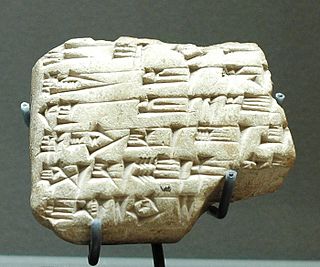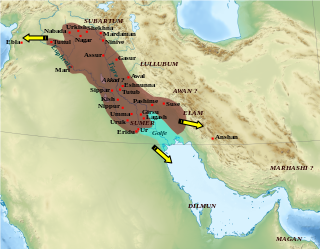
Yamhad (Yamḫad) was an ancient Semitic-speaking kingdom centered on Ḥalab (Aleppo) in Syria. The kingdom emerged at the end of the 19th century BC and was ruled by the Yamhad dynasty, who counted on both military and diplomacy to expand their realm. From the beginning of its establishment, the kingdom withstood the aggressions of its neighbors Mari, Qatna and the Old Assyrian Empire, and was turned into the most powerful Syrian kingdom of its era through the actions of its king Yarim-Lim I. By the middle of the 18th century BC, most of Syria minus the south came under the authority of Yamhad, either as a direct possession or through vassalage, and for nearly a century and a half, Yamhad dominated northern, northwestern and eastern Syria, and had influence over small kingdoms in Mesopotamia at the borders of Elam. The kingdom was eventually destroyed by the Hittites, then annexed by Mitanni in the 16th century BC.

Samsu-iluna was the seventh king of the founding Amorite dynasty of Babylon. His reign is estimated from 1749 BC to 1712 BC, or from 1686 to 1648 BC. He was the son and successor of Hammurabi by an unknown mother. His reign was marked by the violent uprisings of areas conquered by his father and the abandonment of several important cities.

Shamshi-Adad, ruled c. 1808–1776 BC, was an Amorite warlord and conqueror who had conquered lands across much of Syria, Anatolia, and Upper Mesopotamia. His capital was originally at Ekallatum and later moved to Šubat-Enlil.

Yahdunlim was the king of Mari probably in 1820—1796 BC. He was of Amorite origin, and became king after the death of his father Iagitlim. Yahdunlim built Mari up to become one of the major powers of the region. He led a successful campaign to the coast of the Mediterranean.

Lugal-Anne-Mundu was the most important king of the city-state of Adab in Sumer. The Sumerian king list claims he reigned for 90 years, following the defeat of Mesh-ki-ang-Nanna II, son of Nanni, of Ur. There are few authentic contemporary inscriptions for Lugal-Anne-Mundu's reign; he is known mainly from a much later text, purporting to be copied from one of his inscriptions.
Eshnunna was an ancient Sumerian city and city-state in central Mesopotamia 12.6 miles northwest of Tell Agrab and 15 miles northwest of Tell Ishchali. Although situated in the Diyala Valley northwest of Sumer proper, the city nonetheless belonged securely within the Sumerian cultural milieu. It is sometimes, in archaeological papers, called Ashnunnak or Tuplias.
Erishum I or Erišum II, the son and successor of Naram-Sin, was the king of the city-state Assur from c. 1828/1818 BC to 1809 BC. Like his predecessors, he bore the titles “Išši’ak Aššur” and “ensí”. The length of Erishum II's reign is uncertain, however; based on various excavated "limmu" (eponym) lists, Naram-Sin's and Erishum II's reigns had a combined length of 64 years.
Tishpak (Tišpak) was a Mesopotamian god associated with the ancient city Eshnunna and its sphere of influence, located in the Diyala area of Iraq. He was primarily a war deity, but he was also associated with snakes, including the mythical mushussu and bashmu, and with kingship.
Naram-Suen was a king who ruled over Eshnunna for at least nine years during the later 19th century BCE, during its brief time of political power. He is known to be the son of Ipiq-Adad II, king of Eshnunna, and a contemporary of Shamshi-Adad I, king of the Kingdom of Upper Mesopotamia.

Ekallatum (Akkadian: 𒌷𒂍𒃲𒈨𒌍, URUE2.GAL.MEŠ, Ekallātum, "the Palaces") was an ancient Amorite city-state and kingdom in upper Mesopotamia.
Tell Ishchali is an archaeological site in Diyala Province (Iraq) a few hundred meters from the Diyala River and 3 miles south by southeast from the ancient city of Khafajah. It is thought to be ancient Nerebtum or Kiti and was part of the city-state of Eshnunna. It is known to have been occupied during the Isin-Larsa period and Old Babylonian period with excavations ending before earlier levels were reached.
Diniktum, inscribed Di-ni-ik-tumKI, was a still unlocated middle bronze-age town often thought to be located somewhere in the Diyala Governorate of Iraq.

Akkad was the capital of the Akkadian Empire, which was the dominant political force in Mesopotamia during a period of about 150 years in the last third of the 3rd millennium BC.

Dadusha (Dāduša) was one of the kings of the central Mesopotamian city Eshnunna, located in the Diyala Valley. He was the son of the Eshnunna king Ipiq-Adad II. Although previously kings of Eshnunna had referred to themselves as ensi (governor) of the city god Tishpak, in the early 19th century rulers of Eshnunna began referring to themselves as King. Dadusha's father Ipiq-Adad II and his brother Naram-Suen, who ruled Eshnunna before him, both used the title king and Dadusha followed suit.

The timeline of ancient Assyria can be broken down into three main eras: the Old Assyrian period, Middle Assyrian Empire, and Neo-Assyrian Empire. Modern scholars typically also recognize an Early period preceding the Old Assyrian period and a post-imperial period succeeding the Neo-Assyrian period.
Malgium is an ancient Mesopotamian city tentatively identified as Tell Yassir which thrived especially in the Middle Bronze Age, ca. 2000 BC - 1600 BC. Malgium formed a small city-state in an area where the edges of the territories controlled by Larsa, Babylon and Elam converged. Inscribed in cuneiform as ma-al-gi-imKI, its chief deities were Ea and Damkina. A temple of Ulmašītum is known to have been there. There was also a temple to the goddess Bēlet-ilī called Ekitusgestu as well as a temple to the god Anum.
Rapiqum, ra-bi-qa-wiKI, was a city of the ancient Near East. The city was located in the north of Mesopotamia, probably on the eastern bank of the Euphrates River, in modern Iraq. It is firmly attested from early in the 2nd Millennium BC until early in the 1st Millennium BC.

Ibal pi’el II was a king of the city kingdom of Eshnunna in ancient Mesopotamia. He reigned c. 1779–1765 BC).

Simurrum was an important city state of the Mesopotamian area from around 2000 BCE to 1500 BCE, during the period of the Akkadian Empire down to Ur III. The Simurrum Kingdom disappears from records after the Old Babylonian period. It is thought that in Old Babylonian times its name was Zabban, a notable cult center of Adad. It was neighbor and sometimes ally with the Lullubi kingdom.
Bilalama was a 20th century BCE ruler of Eshnunna, an ancient Mesopotamian kingdom located in the Diyala Valley in modern Iraq.











